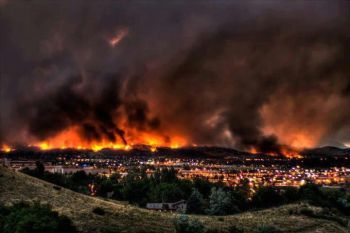
Publisher:
Bonnie King
CONTACT:
Newsroom@Salem-news.com
Advertising:
Adsales@Salem-news.com

~Truth~
~Justice~
~Peace~
TJP
Feb-26-2014 00:38

 TweetFollow @OregonNews
TweetFollow @OregonNews
Waldo Canyon Report Offers Roadmap on How Communities Can Reduce Wildfire Risks
Salem-News.com“Lessons from Waldo Canyon” is the first post-disaster field investigation report from the Fire Adapted Communities Coalition
 techland.time.com |
(TAMPA) - A report detailing vulnerabilities leading to the destruction of nearly 350 homes in Colorado Springs from the 2012 Waldo Canyon Fire provides today’s communities located in wildfire-prone areas guidance on how to reduce their risk of wildfire damage.
“Property insurers are extremely concerned about wildfire, particularly with current severe drought conditions in the western U.S.,” said Julie Rochman, Insurance Institute for Business & Home Safety (IBHS) president and CEO. “The useful post-disaster field research findings in the Waldo Canyon report provide critical insights for property owners. These findings continue to inform the wildfire research conducted by our scientists at the IBHS Research Center – the only facility in the world that can recreate a full-scale wildfire ember storm.”
Among the key findings in the Lessons from Waldo Canyon report produced by the Fire Adapted Communities (FAC) Coalition are:
- Creating and maintaining effective defensible space around homes and businesses, and using ignition-resistant construction techniques are critical to reducing a building’s risk of igniting.
- A community-wide approach to wildfire preparedness that includes all stakeholders substantially improves the chances of successful mitigation efforts. The Colorado Springs Mitigation Section is a good example of this approach. Their actions reduced the number of homes destroyed or damaged during the Waldo Canyon Fire.
- Using fuels management tools to reduce flammable vegetation found around neighborhoods and in more remote areas is an effective way to reduce the spread of a wildfire.
“The damage would have been worse in Colorado Springs if not for the mitigation practices used in this area, including programs to reduce flammable vegetation surrounding the community and instituting a program that facilitated installation of Class A roof coverings when wood-shake roof coverings were replaced,” said Dr. Steve Quarles, IBHS senior scientist and wildfire expert. “The results from this report show the benefits of following wildfire preparedness practices advocated by the FAC Coalition.”
“Lessons from Waldo Canyon” is the first post-disaster field investigation report from the Fire Adapted Communities (FAC) Coalition, a national partnership, in which IBHS is an active members, dedicated to promoting best practices to reduce wildfire-related damage. A companion video, “Creating Fire Adapted Communities: A Case Study from Colorado Springs and the Waldo Canyon Fire,” focuses on the successful loss prevention efforts in Colorado Springs that could help other wildfire-prone communities reduce their risks.
For more information about Fire Adapted Communities, visit www.fireadapted.org. For more information about IBHS and protecting property from a variety of other natural hazards, such as hurricanes, severe winter weather, hailstorms, earthquakes and others, visit www.DisasterSafety.org.
 |
 |
 |
Articles for February 25, 2014 | Articles for February 26, 2014 | Articles for February 27, 2014
Quick Links
DINING
Willamette UniversityGoudy Commons Cafe
Dine on the Queen
Willamette Queen Sternwheeler
MUST SEE SALEM
Oregon Capitol ToursCapitol History Gateway
Willamette River Ride
Willamette Queen Sternwheeler
Historic Home Tours:
Deepwood Museum
The Bush House
Gaiety Hollow Garden
AUCTIONS - APPRAISALS
Auction Masters & AppraisalsCONSTRUCTION SERVICES
Roofing and ContractingSheridan, Ore.
ONLINE SHOPPING
Special Occasion DressesAdvertise with Salem-News
Contact:AdSales@Salem-News.com
googlec507860f6901db00.html


Salem-News.com:

Terms of Service | Privacy Policy
All comments and messages are approved by people and self promotional links or unacceptable comments are denied.
[Return to Top]
©2025 Salem-News.com. All opinions expressed in this article are those of the author and do not necessarily reflect those of Salem-News.com.